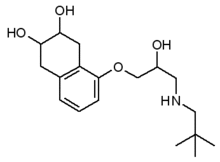Flevari P. Livanis EG, Theodorakis GN, Zarvalis E. Mesiskli T, Kremastinos DT. Vasovagal syncope: a prospective, randomized, crossover evaluation of the effect of propranolol, nadolol, and placebo on syncope recurrence and patients' well-being. J Am Coll Cardiol 2002; 10:499-504.
* BACKGROUND About half of syncopal episodes are vasovagal reactions. Empiric treatment with [beta] blockers is a common practice based on physiologic mechanisms of vasovagal syncope. Only 3 prospective, randomized controlled trials have been done to compare a [beta]-blocker (atenolol) with placebo; no study showed reduced syncopal episodes. No studies have been published on [beta]-blockers other than atenolol.
* POPULATION STUDIED The authors enrolled 30 consecutive patients with recurrent vasovagal syncope. The mean age of the subjects was 41 years; 17 (57%) were women. Investigators defined recurrent vasovagal syncope as at least 2 episodes in the past 3 months and a positive tilt test response. Patients had normal cardiovascular examinations and no electrocardiographic changes. Patients were excluded who had known or suspected autonomic failure (including diabetes), hypertension, chronic obstructive pulmonary disease, or peripheral vascular disease. Patients were recruited from an outpatient cardiology setting, potentially representing a different population than encountered in many primary care settings.
* STUDY DESIGN AND VALIDITY This study was an unblinded, crossover placebo-controlled trial. Patients were assigned to receive 3 drugs in random order for 3 months each. Study drugs were the maximum tolerated dose of propranolol (Inderal) 20 to 40 mg 3 times daily, nadolol (Corgard) 40 to 80 mg once daily, and placebo 1 capsule once daily. Investigators were not blinded but patients were. However, patients took propranolol 3 times daily compared with once daily for placebo and nadolol. To minimize the effect of dosing frequency, investigators advised patients that frequency had no relationship with efficacy. Concealed allocation was not performed. All 30 patients completed the study, although 1 patient withdrew from propranolol therapy due to fatigue. Results were analyzed by intention to treat.
This study is sufficiently well done to allow conclusions on the efficacy of the 2 [beta]-blockers versus placebo. A power calculation was not performed. although the crossover design significantly increases power by having each patient serve as his or her own control. Failure to double-blind and to use concealed allocation typically compromises a study's validity. However, such flaws usually increase the effect of the experimental treatment. Because no statistically significant differences between placebo and treatment groups were found in this study, these study design limitations are of less concern.
* OUTCOMES MEASURED The primary outcome measured was the number of syncopal and presyncopal events during each study drug's 3-month period. Additionally, patients' assessed their quality of life and reported which therapies they preferred. Quality of life was scored from 0 to 4 based on vasovagal symptoms, drug side effects, and personal well being during therapy (0 = very dissatisfied and 4 = excellent).
* RESULTS Overall, no difference was noted in the number of syncopal episodes or quality of life scores during the 3 study periods. Propranolol, nadolol, and placebo equally improved outcomes as compared with baseline (0.25, 0.25, and 0.5 episodes during 3 months respectively vs 3.4 episodes per 3 months; P < .0001). Similar benefits were seen for presyncopal episodes (2.1, 1.3, and 2.6 episodes during 3 months, respectively vs 9.1 episodes per 3 months; P < .0001). Patients' quality of life scores improved with propranolol, nadolol, and placebo as compared with baseline (3.1. 3.5, and 3.4 on a scale of 4, respectively vs 1.5; P < .0001). At the conclusion of the study, 4 patients preferred nadolol, 2 preferred placebo, and 3 preferred propranolol. Five patients were dissatisfied with propranolol due to fatigue. The remaining 70% of patients were satisfied with all 3 regimens.
RECOMMENDATIONS FOR CLINICAL PRACTICE
Most patients with vasovagal syncope had a profound response to [beta]-blocker therapy with a marked decrease in episodes during a 3-month period. However, the patients had a similar response when treated with placebo. Because we do not use placebos frequently in practice and no other therapies have proven benefit above the placebo response, dosing with a [beta]-blocker, if well tolerated, is an option for treating this type of syncope.
COPYRIGHT 2002 Dowden Health Media, Inc.
COPYRIGHT 2002 Gale Group



